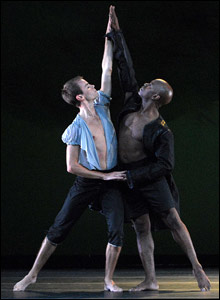
PARTIAL LINKAGES? Noah Vinson and Joe Bowie channel Mozart.
|
NEW YORK — Mark Morris has worked with the Mostly Mozart Festival before, but this year’s commission from the 40-year-old summer music series posed a large-scale challenge, a full evening of new work. For Mozart Dances, Morris resisted the obvious gambit: the potpourri program with an introductory group work, a dark piece, and an upbeat closer, in different styles and combinations of dancers. Instead, he went for an all-piano repertoire (Concertos Nos. 11 and 27 and the Sonata in D for Two Pianos, K.448), with three pure-dance pieces named after the music, all using essentially the same complement of 16 dancers. Distinguished pianist Emanuel Ax played all three pieces, joined by Yoko Nozaki in the sonata. The Mostly Mozart Festival Orchestra was conducted by Louis Langrée.
High culture doesn’t get much higher than this. The 2700-seat New York State Theater was filled for last week’s three performances. Morris seemed to have a scheme in mind as grand as the occasion.
Even though each dance with its musical foundation was self-contained, I thought he was working out an extended framework for his old preoccupation with gender roles and role playing. Morris usually underlines or subverts some dramatic circumstance suggested by a musical text, like the love lyrics of Schubert or Monteverdi. Or he flattens out gender assumptions altogether by treating males and females exactly alike — see the unisex Snowflakes in The Hard Nut (his version of The Nutcracker). With no words to rely on, Mozart Dances draws attention to gender stereotypes and possibilities by staging them on a grand scale.
The very first image in the first dance is a line-up of dancers silhouetted against a backdrop painted with three calligraphic brushstrokes (by designer Howard Hodgkin). As the lights come up, every other dancer comes forward. The men have separated from the women, a distinction that’s maintained for most of the evening. Morris is saying, all theater dancing carries certain implications: this is what men do, this is what women do. He sets out to show us alternatives.
Although the eight men begin Eleven, they soon leave and the women take over. Buoyant, expansive, Lauren Grant dances the piano part of the concerto and the others answer her en masse. She’s never one of them, but they watch her and seem lost without her, and she finally leads them in dutiful daisy chains.
ADVERTISEMENT
 |
In the second ballet, Double, Joe Bowie also stands apart from the rest of his group. In frock coat, bare chest, and knee-length tights, he demonstrates frilly gestures and mannered behavior like an 18th-century ballet master. They copy him, and Mozart, alternating dainty gentility with big galumphing runs. The audience doesn’t know whether to laugh.
In Twenty-seven, the men and women have met, but for much of the time they stay in two separate unison blocks, recapitulating phrases from the earlier ballets. Each person has a small solo — half of them may be doubling the choreography of someone of the opposite sex. They pair off into heterosexual couples, and after some ungainly lifts and twinned partner work, the two big blocks get re-established at the very end, with the men and women mixed.
Morris illustrates music in ways I find obvious. When it springs in the air, the dancers do too. When it make little trills and roulades, they skitter in circles and twirl their wrists. He most appeals to me when his ideas don’t depend wholly on the musical structure.
The men in Double begin a large circular pattern, holding hands, dipping and rising, a dance you’d expect women to do. This leads to a long, beautiful development of broken connections and partial linkages. A man in the center of a new circle bourrées on his toes, falls, tries to break out. Bowie suddenly produces the eight women, in long white skirts, and incites the men to more girlish gestures and mincing walks, more circles, more mysterious and ambiguous adventures.